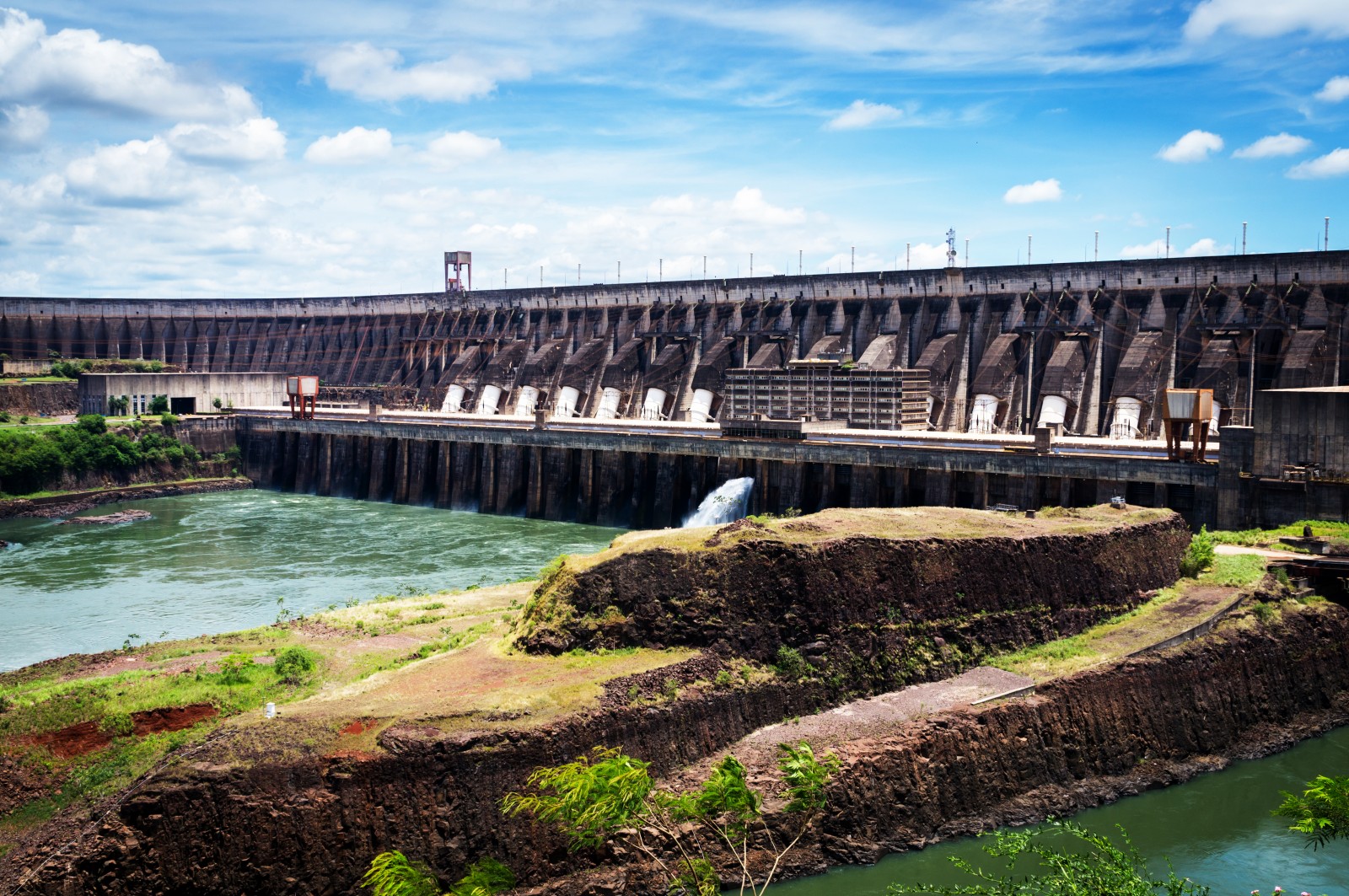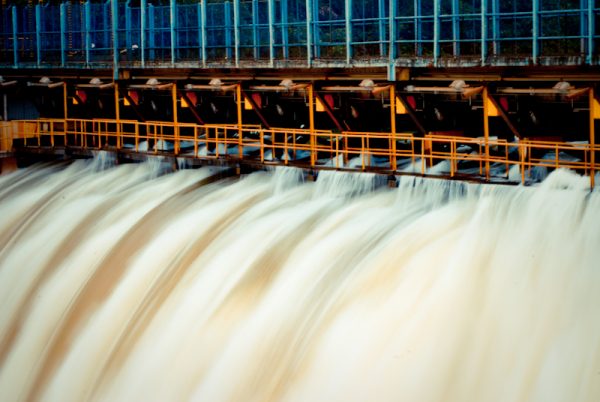Low water, less hydropower revenue prompt U.S. utility to seek a buyer of Latin America power plants.

Hydropower provides more than three-quarters of Brazil’s electricity. Recent droughts have called into question the reliability and economic performance of such dams. Photo courtesy Deni Williams via Flickr Creative Commons
By Keith Schneider
Circle of Blue – June 16, 2016
In July 2015, just 11 months ago, the analysts at Seeking Alpha, an investor research group, declared that Duke Energy’s Latin American power stations were “a cornerstone of the company’s growth strategy given its access to the energy hungry Latin American market.”
In February, in a striking turnabout, Duke announced it was putting its South American assets up for sale. The decision, driven in part by low production and reduced revenue from Duke’s hydropower plants in Brazil, will end nearly two decades of investment and management of electrical infrastructure by Duke Energy in Latin America.
The sudden turn in Duke’s South American business is a striking display of how water-related ecological distress contributes to economic instability that can quickly disrupt operations at even the largest industrial companies.
Since 1999, when America’s largest electricity producer purchased hydropower plants along two rivers in Brazil, the North Carolina-based company expanded its Duke Energy International holdings to coal, natural gas, and hydropower stations in Argentina, Bolivia, Chile, Ecuador, El Salvador, Guatemala, and Peru. The company’s total generating capacity in Latin America reached 4,392 megawatts. About half of that is produced in Brazil, from 10 hydropower plants, eight of them on the Paranapanema River in the state of São Paulo.
Through most of the last two decades the directors of Duke Energy, which earned total revenues of $US 23.5 billion last year, joined utility stock analysts in viewing Duke’s Energy International division as a smart investment that was invaluable to the company’s revenues and profits.
But a deep drought in São Paulo in 2015 sharply cut production and revenues from its Brazilian hydropower plants. Moreover, changes in the dollar exchange rates in several countries, particularly Peru, hurt revenue and earnings. Political volatility in Brazil and several more countries also hindered economic development and made it more difficult to operate in Latin America, said analysts.
Global Water-Related Stress Affects Industry
The sudden turn in Duke’s South American business is a striking display of how water-related ecological distress contributes to economic instability that can quickly disrupt operations at even the largest industrial companies. All across the globe big energy companies are encountering unexpected and severe water-related stresses that destabilize operating conditions and risk stranding valuable economic assets.
Major hydropower plants were wrecked by disastrous floods in India in 2013. Two huge coal-fired power stations in South Africa may be unable to operate at full efficiency due to water scarcity. Two Andes gold mines have been shut down in the last several years by communities concerned about water pollution. Chinese authorities curtailed plans to build 100 coal-fired power stations, due in part to water scarcity in the dry Yellow River basin.
Duke Energy seeks to evade losses by selling its South American power plants, which one U.S. investment group valued at more than $US 2 billion.
“Our international earnings are more volatile than our U.S. regulated utility earnings and we are interested in more stable earnings over time that support our dividend,” said Thomas Williams, Duke Energy’s director of corporate media relations, in an interview. “Some of it is due to unfavorable exchange rates. Some is due to the changes in the dispatch order of the plants due to the drought. Energy International is a small part of our holdings, less than 10 percent.
“What we are interested in are steady reliable earnings over time. It became clear Energy International no longer fit our investment profile.”
Duke Under Stress
The sale of Duke Energy International also caps a rugged two years for the company.
Pollution in North Carolina is one area of public concern. In February 2014, a coal ash pond ruptured and spilled 39,000 tons of toxic pollutants into the Dan River in North Carolina. The company last year reached a $US 102 million settlement with the U.S. Department of Justice over criminal charges connected to the disaster. The state of North Carolina last year levied a $US 25 million fine against the company for the Dan River spill and for polluting groundwater beneath a coal ash pile at a second power station. In February, North Carolina and Duke settled the fine for $US 6.6 million.
Design and operating issues, another area of trouble, are driving up costs at Duke Energy’s three-year-old, 618-megawatt, coal-gasification power station in Indiana. The advanced technology plant, designed to reduce air contaminants, was supposed to cost $US 2.1 billion. Its total cost has soared to $US 3.5 billion amid equipment and operating weaknesses that prevent it from running at full capacity.
Thomas Williams, the Duke Energy spokesman, disputed news stories in Indiana that reported problems at the advanced technology power station. “The plant’s capacity factors have been in line with new power plants coming on-line,” he said.
South American Interest
Duke entered the South American market when it paid $US 680 million to purchase Companhia de Geração de Energia Elétrica Paranapanema, Brazil’s 11th largest electric generating company. Paranapanema has 2,274 megawatts of generating capacity from ten hydroelectric plants along the Paranapanema and Sapucaí Mirim rivers.
One factor that interested Duke in South America’s growing electricity markets two decades ago was the opportunity to sell power directly to customers at rates that are higher than in the regulated U.S. electricity markets. The price difference helped the company’s profitability. In 2012, for example, according to company figures, earnings before interest, taxes, depreciation, and amortization from the Energy International division were roughly 42 percent. Earnings after the same charges for its U.S. operations were 32 percent of revenue.

Duke Energy, the largest electricity producer in the United States, is trying to sell its South American assets, including eight hydropower plants on the Paranapanema River in Brazil. Photo courtesy Luiz Gustavo Leme via Flickr Creative Commons
At the time of the Brazil deal, Duke executives expressed great confidence in their investment.
“Paranapanema is an excellent addition to DEI’s growing Latin American portfolio of integrated energy assets and trading and marketing business,” said the Duke Energy International’s chief executive, Bruce Williamson, in a statement. “Paranapanema provides DEI opportunities to supply the region’s growing demand for electricity and energy services.”
Until 2015, adjusted income from the Energy International plants was strong, typically more than $US 400 million. Last year, though, adjusted income fell to $US 225 million. Duke Energy’s stock price also sank.
“The returns over the last two years are inconsistent with our commitment to investors to provide predictable, stable earnings and cash flows. We believe there will be demand for this international portfolio at a reasonable valuation,” said Lynn Good, Duke’s chief executive, during a call with analysts earlier this year. “The strategic exit significantly improves our risk profile and enhances our ability to generate more consistent earnings and cash flows over time.”
Selling South American power plants has turned out to be a strong signal to investors. Since the sale of Duke’s South American assets was announced in February, the company’s stock price has shifted direction and reached more than $US 82 a share, higher than any time since February 2015.
Circle of Blue’s senior editor and chief correspondent based in Traverse City, Michigan. He has reported on the contest for energy, food, and water in the era of climate change from six continents. Contact
Keith Schneider




